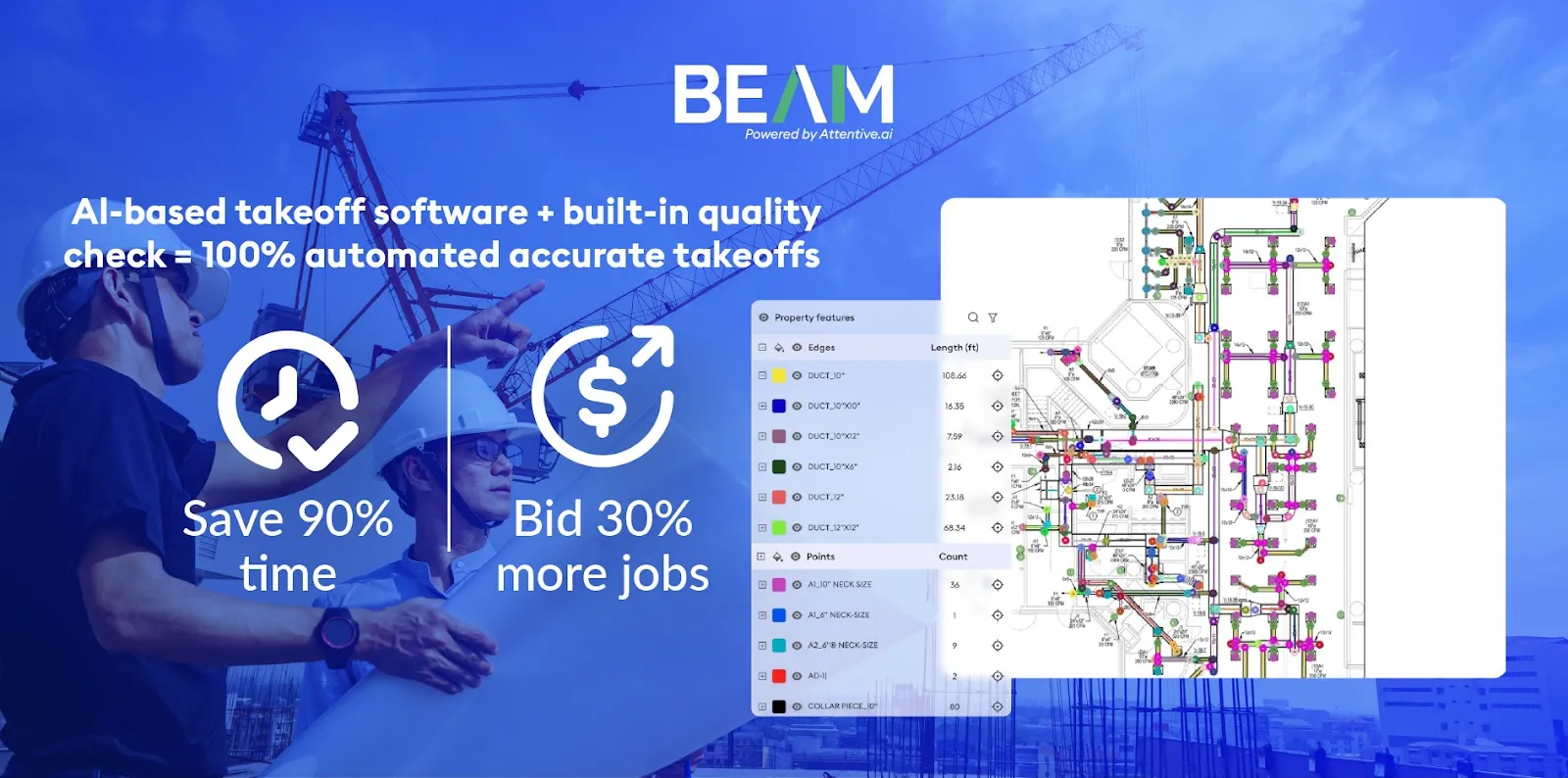How to Estimate Equipment Costs Effectively And Win More Profitable Bids

Getting equipment costs wrong is one of the fastest ways to lose money on a project.
One minute, you’re checking fuel consumption on a rented dozer. Next, you’re chasing updated rental rates from three suppliers. Oh, and that project deadline? It was yesterday.
Miss one detail and your margins go out of the window.
If you’re in preconstruction or part of an estimating team, nailing your construction cost estimate, especially for equipment, is a no-brainer. Because when you get it right, you don’t just win bids. You win profitable bids.
In this guide, we’ll break down how to estimate equipment costs effectively. And yes, we’ll show you how AI-powered construction takeoff software can make the whole process faster and less error-prone.
Why Equipment Costs Are Deal-Makers (or Breakers)
Whether you use construction estimating software, spreadsheets, or sticky notes, one thing’s certain—equipment is one of the biggest cost drivers in any bid.
Get it wrong and you’re either:
❌ Eating into your profit due to cost overruns
❌ Overpricing your bid and losing to a competitor
❌ Missing hidden costs like downtime or transportation
Equipment choices depend directly on your measured volumes and quantities so accuracy here means accuracy in equipment costing.
What Goes Into Estimating Equipment Costs?
To create accurate construction estimates, you need more than just a price per day. Here’s what should go into your equipment cost breakdown:

1. Buy or Rent?
Owned equipment requires you to account for:
- Depreciation
- Insurance
- Storage
- Taxes
Rented equipment? Watch for:
- Daily/hourly rates
- Fuel surcharges
- Minimum time blocks
- Delivery and pickup fees
For example, renting an excavator may cost $400/day, but owning involves insurance, taxes, and depreciation, potentially cheaper long-term, depending on your quantified usage.
2. Time on Site
Estimate usage by the hour or day based on the project timeline. Be realistic. Factor in downtime or bad weather. This helps avoid underbidding.
3. Operational Costs
The real cost of using equipment includes:
- Fuel consumption
- Operator wages
- Maintenance
- Breakdown risks
Operational costs scale directly with quantities from your takeoffs. For instance, more earthwork volume equals more fuel, operator hours, and maintenance.
This is often overlooked in standard construction estimating workflows.
4. Transportation
Hauling costs can sneak up on you, especially for larger machines. Always account for loading, unloading, and special permits.
Include transport for each piece of equipment identified by your takeoffs, especially large or heavy machinery.
5. Idle Time = Wasted Spend
Every minute your equipment isn’t working is still costing you money. Even worse if you’re renting.
Use the Right Tools: Estimating Equipment Costs with Confidence
Outdated contractor estimating software or manual methods just don’t cut it anymore. If your process still involves dragging a mouse across drawings or printing out specs—there’s a better way.
Accurate Equipment Costs Start with Accurate Takeoffs
Before you can confidently estimate equipment costs, you must first know exactly how much material you’re moving, installing, or removing. Equipment costs don’t exist in isolation; they're directly tied to your quantity and material takeoffs.
Think about it: if your takeoff overquantifies earthwork volume, you'll overestimate how long you need your excavators on site, raising your bid unnecessarily and possibly losing the project to competitors. Underestimate, and you'll face costly delays or rushed equipment rentals that destroy your margins.
In other words, accurate takeoffs are foundational here. The precision of your equipment estimates and ultimately, your profitability rests entirely on getting those quantities right.
In short:
Project Scope → Accurate Quantity Takeoffs → Precise Equipment Estimation → Profitable Bids
Get step two wrong, and everything after becomes guesswork. Get it right, and you’re already ahead of the competition.
Beam AI: The Smartest Way to Start Any Estimate

Before you even touch the numbers, you need accurate quantities. Because if your takeoffs are off, your equipment estimates will be too.
This is where Beam AI steps in.
Beam AI your go-to AI-based construction takeoff software that:
✅ Automates quantity takeoffs across all trades
✅ Delivers takeoffs in 1-3 days validated by an estimator
✅ Helps you submit 30% more bids
✅ Saves you 90% of the time you usually spend measuring
That means you get more accurate data, earlier in your workflow—giving you the power to price equipment more precisely and bid faster.
Why It Works: Better Takeoffs = Better Equipment Estimates
When you use Beam AI as software for construction estimates, your entire estimating process improves:
- You don’t waste time redoing takeoffs when specs change
- You have accurate volumes, square footage, and quantities at your fingertips
- Your bids become more competitive without sacrificing margins
Reclaim your time and money.
Final Thoughts: What the Best Estimators Know
Whether you’re using a full-blown estimation software for construction or still figuring things out, one truth remains—accuracy wins.
The best estimators know how to build competitive, risk-aware bids. And the right construction estimating starts with accurate takeoffs.
Beam AI gives you that edge—so you can focus on what actually drives profits: strategy, pricing, and relationships.
Ready to stop guessing and start winning?
Book a Demo of Beam AI and see how the #1 AI takeoff software helps you estimate equipment costs better—and win more profitable bids.
Table of content
.webp)
.webp)





.png)




